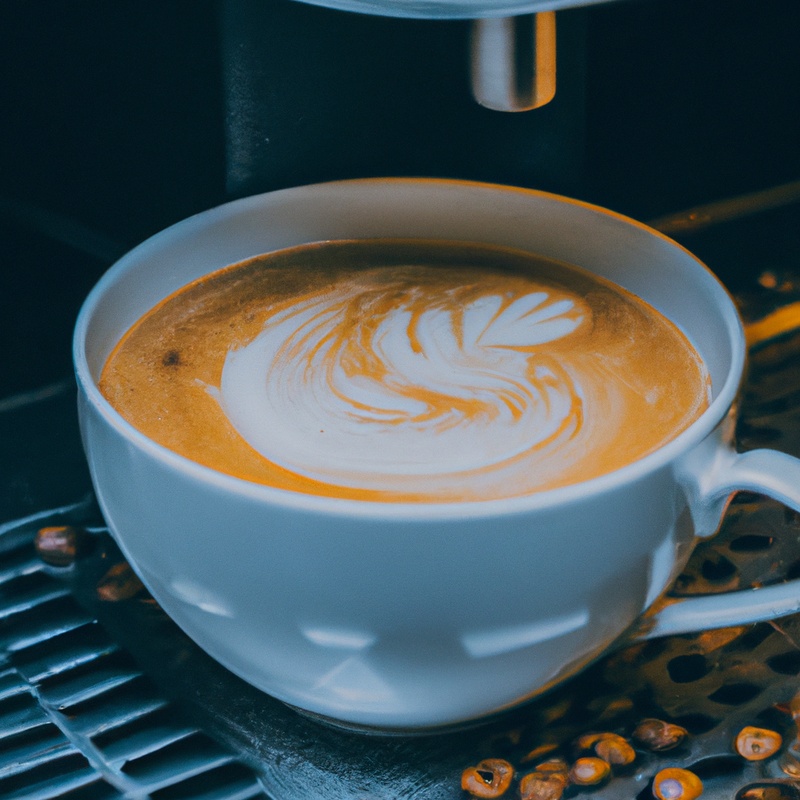Key Takeaways:
- Use a cold brew coffee maker or jar to make a large batch of cold brew coffee.
- Transfer the cold brew coffee into a keg and keep it refrigerated to maintain its freshness.
- Serve the cold brew coffee on tap, ensuring a consistently cold and smooth experience.
- Clean and maintain the keg regularly to prevent any spoilage or contamination.
So you’ve fallen in love with the smooth and bold flavors of cold brew coffee. But why stop at simply brewing a batch at home?
Imagine having a keg of cold brew on tap, ready to dispense whenever you crave that caffeinated goodness.
It’s the ultimate coffee lover’s dream! But how exactly do you keg cold brew coffee? In this article, we’ll guide you through the process, step by step, so you can enjoy the benefits of kegging your own cold brew.
Get ready to elevate your coffee game and become the envy of all your coffee-loving friends.
Let’s dive in!
| Method | Steps |
|---|---|
| Gather Supplies | 1. Keg 2. Cold brew coffee concentrate 3. CO2 tank and regulator 4. Kegging equipment (dip tube, gas line, liquid line, etc.) |
| Sanitize | 1. Clean and sanitize the keg, dip tube, and all kegging equipment. 2. Ensure all equipment is thoroughly rinsed. |
| Transfer Coffee | 1. Using a funnel, transfer the cold brew coffee concentrate into the sanitized keg. 2. Leave some headspace at the top of the keg to accommodate carbonation and expansion. 3. Avoid transferring any sediment or grounds from the concentrate. |
| Carbonate | 1. Attach the CO2 tank and regulator to the keg. 2. Set the pressure to the desired carbonation level (typically between 20-30 PSI). 3. Allow the CO2 to fully carbonate the cold brew coffee for 24-48 hours, depending on desired carbonation level. |
| Chill and Serve | 1. Place the keg in a refrigerator or cooler with ice to keep it chilled. 2. Connect a tap or dispensing system to the keg. 3. Pour and serve cold brew coffee directly from the keg. |
What is Cold Brew Coffee?
Cold brew coffee is a brewing method that involves steeping coffee grounds in cool water for an extended period of time, resulting in a smooth and less acidic coffee concentrate.
Definition and Brewing Method
Definition: Cold brew coffee is a method of brewing coffee that involves steeping coarsely ground coffee beans in cold or room temperature water for an extended period of time, usually 12 to 24 hours. This slow extraction process produces a smooth, less acidic and less bitter coffee concentrate.
Brewing Method: To make cold brew coffee, start by grinding your coffee beans to a coarse consistency.
Then, combine the ground coffee with cold or room temperature water in a jar or pitcher. Stir gently to ensure all the coffee grounds are saturated.
Cover and let it steep for 12 to 24 hours, depending on your preference for strength.
Once the steeping time is complete, strain the coffee concentrate to remove the grounds. You can use a fine-mesh sieve, cheesecloth, or a cold brew coffee maker.
Dilute the concentrate with water or milk, and serve it over ice or heat it up if desired.
Cold brew coffee can be stored in the refrigerator for up to a week.
Why Keg Cold Brew Coffee?
Kegging cold brew coffee offers several key benefits.
Benefits of Kegging Cold Brew Coffee
Kegging cold brew coffee offers several benefits.
- Consistent flavor: When you keg your cold brew coffee, it stays fresh for longer periods, ensuring consistent taste and quality.
- Easy to serve: With a keg system, you can easily dispense cold brew coffee on demand, making it convenient for both personal and commercial use.
- Cost-effective: Kegging allows you to make larger batches of cold brew coffee, reducing the overall cost per serving compared to individual bottles or cans.
- Customizable options: You can experiment with different flavors and additives by kegging cold brew coffee, opening up the opportunity for creative and unique drinks.
- Increased shelf life: Cold brew coffee stored in kegs remains fresh for a longer time compared to other storage methods, minimizing waste and ensuring a longer shelf life for your coffee.
Equipment Needed for Kegging Cold Brew Coffee
You’ll need a few key pieces of equipment and tools to keg your cold brew coffee.
List of Essential Equipment and Tools
To keg your cold brew coffee, you’ll need the following essential equipment and tools:
- Keg: Invest in a stainless steel keg with a capacity that suits your brewing needs. A 5-gallon keg is a popular option.
- Nitrogen (N2 or Carbon Dioxide (CO2) Tank: Choose the gas that best suits your preference for dispensing cold brew coffee. Nitrogen provides a creamy texture, while carbon dioxide gives a fizzy quality.
- Regulator: This device regulates the pressure of the gas going into the keg, ensuring that it’s at the appropriate level for serving your cold brew.
- Tap or Faucet: Attach a tap or faucet to the keg for easy pouring. Look for a model with a smooth flow and a design that minimizes foaming.
- Keg Lid: The keg lid, usually with a built-in pressure relief valve, ensures a tight seal and allows for easy access when cleaning or adding coffee.
- Tubing and Connectors: High-quality food-grade tubing and appropriate connectors are necessary for connecting the gas tank, regulator, and tap to the keg.
- Cleaning Supplies: Keep your equipment pristine by using a keg cleaning kit, which typically includes brushes and cleaning solutions designed specifically for kegs.
Remember, this list covers the essential equipment and tools needed for kegging your cold brew coffee. Depending on your individual preferences and setup, you may need additional items such as a kegerator or keg dispenser system.

Step-by-Step Guide to Keg Cold Brew Coffee
Brew the cold brew coffee, transfer it to the keg, carbonate it, and store it properly to enjoy a refreshing kegged cold brew coffee.
1. Brewing the Cold Brew Coffee
To brew cold brew coffee, start by coarsely grinding fresh coffee beans.
Next, combine the ground coffee with cold water in a large container or mason jar.
Stir the mixture to ensure all the coffee grounds are fully saturated.
Cover the container and let it steep in the refrigerator for 12 to 24 hours.
Once steeped, strain the coffee mixture through a fine-mesh sieve or cheesecloth to remove the grounds.
Dilute the cold brew concentrate with water or milk to your desired strength.
Serve over ice or enjoy it hot.
2. Transferring the Cold Brew Coffee to the Keg
To transfer your cold brew coffee to the keg, you’ll need a few simple tools: a siphon, a clean container, and of course, the keg itself. Start by sanitizing all your equipment to ensure freshness and prevent any contamination.
Next, connect the siphon to the container and carefully transfer the cold brew coffee from its current storage vessel to the clean container.
Once the transfer is complete, connect the siphon to the keg and slowly transfer the cold brew into the keg. Seal the keg tightly and refrigerate it for at least 24 hours to allow the flavors to meld.
After that, your keg of delicious cold brew coffee is ready to be enjoyed!

3. Carbonating the Cold Brew Coffee
To carbonate your cold brew coffee, you’ll need a keg and a CO2 tank. Start by transferring your cold brew into the keg, leaving some space for carbonation.
Attach the CO2 tank to the keg and set the pressure to around 30 PSI.
Allow the coffee to carbonate for 12-24 hours in the refrigerator. Once carbonated, reduce the pressure to around 10-12 PSI before serving.
Enjoy your fizzy and refreshing carbonated cold brew coffee!
4. Storing and Serving the Kegged Cold Brew Coffee
To store and serve your kegged cold brew coffee, follow these simple steps:
- CHILL: Keep the keg refrigerated at all times to maintain the freshness and quality of the cold brew.
- TAP: When you’re ready to serve, attach a tap system to the keg and ensure the proper pressure is applied. This will help control the flow and maintain the desired taste.
- SERVE: Fill your cup or glass with the kegged cold brew, allowing it to cascade and settle properly. Enjoy the smooth and rich flavor of your homemade cold brew coffee!
Remember to clean and maintain your keg and tap system regularly for optimal results.
Cheers!

Tips for Kegging Cold Brew Coffee
Adjusting the Carbonation Level
1. Choosing the Right Size Keg
When choosing the right size keg for your cold brew coffee, it’s important to consider your needs and serving requirements. Start by determining how much coffee you plan to brew and serve on a regular basis.
This will help you decide on the appropriate size, whether it’s a 2.5-gallon, 5-gallon, or even a larger keg.
Additionally, think about the storage space you have available and the frequency at which you’ll need to refill the keg. By understanding these factors, you can make an informed decision that suits your specific circumstances.
2. Adjusting the Carbonation Level
To adjust the carbonation level of your cold brew coffee, it’s all about finding the right balance for your taste preferences.
Here are a few simple steps to help you achieve the desired level of carbonation in your keg:
- Start by chilling your cold brew coffee and keg in the refrigerator.
- Connect your keg to a CO2 tank and set the pressure to your desired level.
- Slowly introduce CO2 into the keg by gently pulling the release valve on the keg lid.
- Allow the CO2 to circulate within the keg for a few minutes to ensure even carbonation.
- Taste test by dispensing a small amount of cold brew and adjusting the CO2 pressure accordingly.
- Repeat this process until you achieve the desired level of carbonation.
Remember, adjustments should be made gradually to avoid over-carbonation.
Enjoy experimenting and finding the perfect carbonation level for your cold brew coffee!
3. Adding Flavors or Syrups
When it comes to adding flavors or syrups to your kegged cold brew coffee, there are a few things to keep in mind.
Firstly, it’s important to choose high-quality flavors or syrups that complement the taste of the cold brew.
You can experiment with different flavors like vanilla, caramel, or hazelnut to find your perfect combination.
Secondly, it’s crucial to start with a small amount and adjust according to your preference.
Remember, it’s easier to add more flavor than to remove it.
Finally, make sure to mix the flavor or syrup thoroughly with the cold brew before serving to ensure an even distribution.
Happy brewing!
Frequently Asked Questions about Kegging Cold Brew Coffee
1. Can I keg cold brew made with a coffee concentrate?
Yes, you can keg cold brew made with a coffee concentrate. In fact, using a coffee concentrate can make the kegging process even easier.
Just dilute the concentrate with water to your desired strength, then transfer it to a keg and carbonate it.
This allows you to have a ready-to-serve cold brew on tap, which is convenient and perfect for serving multiple cups at once. Just make sure to properly store and handle the keg to maintain the freshness and quality of your cold brew.
2. How long will kegged cold brew coffee last?
Kegged cold brew coffee can last for up to 2-3 weeks when stored properly. It’s important to keep the keg refrigerated at all times to maintain freshness and prevent any bacterial growth.
Make sure to purge the keg with CO2 to reduce oxygen exposure and extend the shelf life.
Regularly tasting the cold brew will help you determine when it starts to lose its flavor and quality.
3. Can I use a regular keg for cold brew coffee?
Yes, you can use a regular keg for cold brew coffee! Regular kegs, like those used for beer, work perfectly fine for storing and dispensing cold brew coffee. Just make sure to clean and sanitize the keg thoroughly before using it for coffee.
Use a food-grade CO2 tank and regulator to pressurize the keg and keep the coffee fresh.
Enjoy your delicious cold brew straight from the keg!
Final Verdict
Kegging cold brew coffee offers numerous benefits and advantages.
Not only does it provide a convenient way to store and serve large quantities of cold brew, but it also allows for easy customization and carbonation options.
By following a simple step-by-step guide and investing in the necessary equipment, anyone can keg their own delicious cold brew coffee at home.
Remember to choose the right size keg, adjust the carbonation level to your preference, and get creative with flavors or syrups.
With these tips and techniques, you’ll be well on your way to enjoying fresh, flavorful cold brew coffee anytime you want.
So why wait?
Start kegging your cold brew and elevate your coffee experience today.
